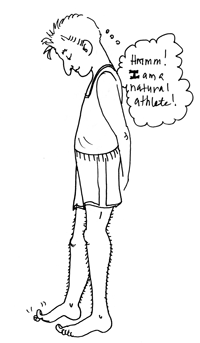STRANGE BUT TRUE- Athlete's foot: Big toe gives skiiers an edge

DRAWING BY DEBORAH DERR McCLINTOCK
Q. Without looking, can you say whether your big toes are longer than your second toes? Asked another way, do you have a natural athlete's foot? –J. Esposito
A. Most people's second toes are longer, but if your big first toes extend farther, you possess a natural advantage in skiing, sprinting, and certain other sports, says Peter Weiss in "Remarkable Feets" from Exploring Magazine. Now you can more readily lean your full body weight onto your big toes, great for rapid acceleration or for planting them to cut an edge.
"Your big toe can exert about twice as much force as your second toe," Weiss says.
Footwork forms the foundation of most sports– as springs and levers that cushion and propel you (football, soccer), as launching pads for leaping (basketball, volleyball), or as brakes and pivots for side-to-side motion (tennis, aerobics).
Other special endowments: the first metatarsal bone in some feet hangs slightly lower, also aiding in pushing off (but risking bruises or fractures under repeated pounding, as in long-distance running). Rigid feet are better suited for sprinting and jumping, flexible feet for racquetball and tennis, says San Francisco podiatrist Richard Blake. Yet while most of us miss out on the big-toe edge, concludes Weiss, we all gain from the foot's varied ancestry and "its remarkable versatility for almost any kind of sport."
Q. Was it human hubris or flawed design that sank the "unsinkable" luxury liner Titanic on its maiden voyage, killing 1,500 people out of the 2,200 on board, the world's most famous maritime disaster? –L. DiCaprio
A. Blame it on a little pride and a lot of bad engineering, says Adam Weiner in Don't Try This at Home: The Physics of Hollywood Movies. The ship had design innovations that theoretically should have made it safer, such as the hull's 16 separate buoyant compartments divided by watertight doors. It was touted that the ship could stay afloat even if four of its sections were breached, but tragically on that night of April 14, 1912, a massive iceberg that outweighed the ship by about 5 to 1 punctured six compartments near the bow. In under three hours, the ship sank to the bottom of the Atlantic near Newfoundland.
The design failure was that the bulkheads dividing the compartments came up only 10 feet above the waterline, beyond which water would start flooding adjacent sections even if intact.
"If the compartments had been completely watertight– that is, if water could not spill over the tops of the bulkheads– the Titanic would not have sunk," Weiner writes.
Q. From a societal standpoint, what's one of the most troubling things about unhappy people? –E. Kelly
A. Their tendency to pass along the bad feelings to others. Unhappiness can be viewed as a form of stress, say Eduardo Punset and Robert Sapolsky in The Happiness Trip: A Scientific Journey. Depressed people are in effect giving up, saying to themselves, "I've tried everything and nothing helps, so why keep trying?" Now the all-too-ready antidote is to dump one's own stress onto others. Statistics show this happens en masse during any national economic downturn, when husbands are more inclined to physically abuse their wives, parents to abuse their kids, and so on.
We humans are such stress-prone beings that the threat to us doesn't even have to be present, such as a lion approaching our camp. We can just imagine an approaching lion or imagine all the problems we might face 10 years from now, after retirement. Unfortunately, there's a lot of evidence that making others unhappy "helps us cope with stress, which contributes to making the world a much worse place. Many people avoid developing ulcers at the cost of causing them in others."
Q. Using "end-9 pricing," producers and product pricers try to yank the strings of us poor harried consumers. Do they succeed? –J.D. Rockefeller
A. You can bet the stratagem works, also called "odd- pricing" or "pricing in the nines." You've seen it millions of times, a gambit that's at least a century old, of unknown origin, and done now round the world. Why it works so well is a matter of psychology and speculation, says University of Notre Dame marketing professor William L. Wilkie in Consumer Behavior. The speculations are themselves fascinating:
#1. Charge $1.49.9 for a gallon of gas instead of $1.50 and the gas looks cheaper because the eye is drawn first to the lower digits on the left, so the wearied brain reads the price as being "in the $1.40s."
#2. The circles in all those nines attract attention.
#3. Odd-prices like $1.99 in stores force the clerk to make change, and people like receiving change.
#4. End-9 prices become so associated with discounts that they automatically connote savings.
Obviously, all four of these can operate simultaneously. So powerful is the effect that studies show products like cookies will sell faster at $.99 than the same items at $.98, $.97 or even $.96!
Send Strange questions to brothers Bill and Rich at [email protected].
#